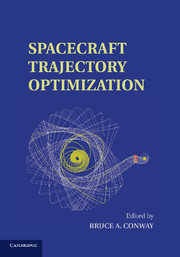Book contents
- Frontmatter
- Contents
- Preface
- 1 The Problem of Spacecraft Trajectory Optimization
- 2 Primer Vector Theory and Applications
- 3 Spacecraft Trajectory Optimization Using Direct Transcription and Nonlinear Programming
- 4 Elements of a Software System for Spacecraft Trajectory Optimization
- 5 Low-Thrust Trajectory Optimization Using Orbital Averaging and Control Parameterization
- 6 Analytic Representations of Optimal Low-Thrust Transfer in Circular Orbit
- 7 Global Optimization and Space Pruning for Spacecraft Trajectory Design
- 8 Incremental Techniques for Global Space Trajectory Design
- 9 Optimal Low-Thrust Trajectories Using Stable Manifolds
- 10 Swarming Theory Applied to Space Trajectory Optimization
- Index
- References
1 - The Problem of Spacecraft Trajectory Optimization
Published online by Cambridge University Press: 06 December 2010
- Frontmatter
- Contents
- Preface
- 1 The Problem of Spacecraft Trajectory Optimization
- 2 Primer Vector Theory and Applications
- 3 Spacecraft Trajectory Optimization Using Direct Transcription and Nonlinear Programming
- 4 Elements of a Software System for Spacecraft Trajectory Optimization
- 5 Low-Thrust Trajectory Optimization Using Orbital Averaging and Control Parameterization
- 6 Analytic Representations of Optimal Low-Thrust Transfer in Circular Orbit
- 7 Global Optimization and Space Pruning for Spacecraft Trajectory Design
- 8 Incremental Techniques for Global Space Trajectory Design
- 9 Optimal Low-Thrust Trajectories Using Stable Manifolds
- 10 Swarming Theory Applied to Space Trajectory Optimization
- Index
- References
Summary
Introduction
The subject of spacecraft trajectory optimization has a long and interesting history. The problem can be simply stated as the determination of a trajectory for a spacecraft that satisfies specified initial and terminal conditions, that is conducting a required mission, while minimizing some quantity of importance. The most common objective is to minimize the propellant required or equivalently to maximize the fraction of the spacecraft that is not devoted to propellant. Of course, as is common in the optimization of continuous dynamical systems, it is usually necessary to provide some practical upper bound for the final time or the optimizer will trade time for propellant. There are also spacecraft trajectory problems where minimizing flight time is the important thing, or problems, for example those using continuous thrust, where minimizing flight time and minimizing propellant use are synonymous.
Except in very special (integrable) cases, which reduce naturally to parameter optimization problems, the problem is a continuous optimization problem of an especially complicated kind.
- Type
- Chapter
- Information
- Spacecraft Trajectory Optimization , pp. 1 - 15Publisher: Cambridge University PressPrint publication year: 2010
References
- 14
- Cited by

